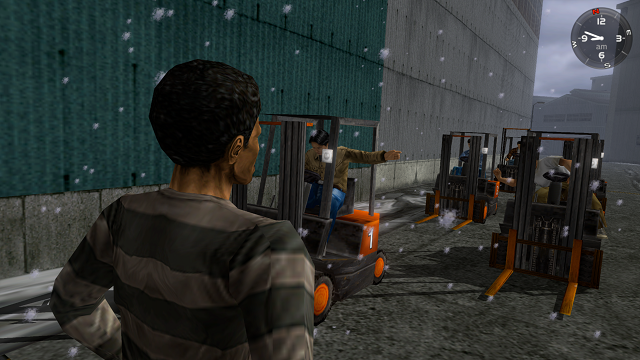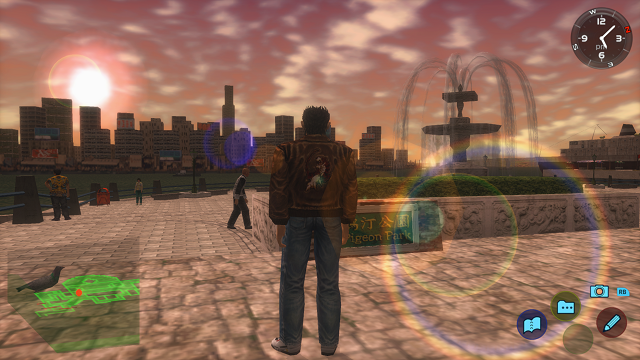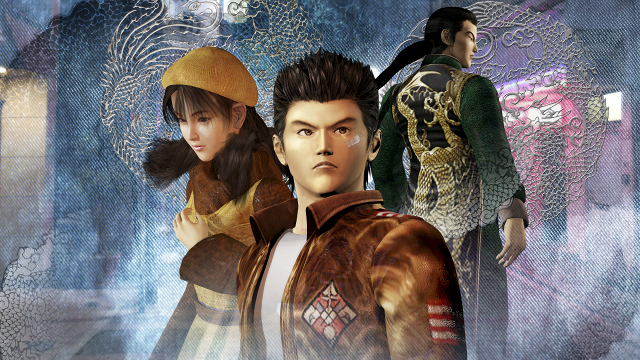Many of us that fell in love with Shenmue when it released for the Dreamcast in 1999 had spent many hours of our formative years watching some of the best martial arts films of the 1970s, 80s, and 90s. Following in the footsteps of classics such as Shaolin Temple, Enter the Dragon, Kickboxer, and even Rumble in the Bronx, Shenmue’s narrative of revenge and intrigue used much of what we enjoyed about those films to craft a digital world as engrossing as it was stunning.
For its time, the game captured hearts and minds because of its unique twist on open-world gameplay. A mixture of lifesim and adventure game, RPG and martial arts brawler, Shenmue challenged the status quo by embracing its own pseudo-realism. It could be as mundane and exciting all at once. That’s what made it fun.
In 2001, SEGA and Yu Suzuki released a sequel, Shenmue 2. Although not as well received by fans at the time, this second effort garnered plaudits from critics and has since become a cult classic because it improved some of the more tedious elements of Shenmue by implementing additional quality of life improvements to the proven formula, such as minimap and wait mechanics. It also continued the engrossing story of the first game, while considerably increasing the size of the game world.
It’s a shame more players didn’t experience Shenmue 2 when it originally launched for the Dreamcast in Europe and Japan or after it was ported to the Xbox in North America a year later.

However, the time has come to rectify that tragedy with the Shenmue 1+2 remastered collection. Here, SEGA has created a remaster that faithfully captures Suzuki’s lightning in a bottle for a new generation of players.
Right off the bat, it’s easy to see that both games look leagues better than the original titles. Character models are refined and clear, while landscapes are crisper and more defined. Lens flare and water in Shenmue 2 appear as if they were taken from a last-gen title, which is saying something for a game that’s old enough to graduate high school.
On the PC version of the collection, there’s quite a bit to tweak when it comes to graphics. From anti-aliasing, bloom, and contrast to aspect ratio and resolutions up to 4K, players can dial in some pretty hefty visual upgrades. Running on a high-end gaming PC, we maxed out Shenmue 1+2 and while it did show its graphical age with some inherent blockiness, the results were nonetheless enjoyable. On top of that, and as would be expected, both games ran at a smooth and constant 30fps (at which they’re locked), and we experienced no tearing or choppiness, with load times being nearly instantaneous.
When it comes to controlling Ryo, using a controller is best; this game just wasn’t built for mouse and keyboard, even if it is supported in the PC version of the collection. Despite the game now allowing you to use a control stick for movement, Shenmue retains its original tank-style movement, where Ryo moves in more robotic motions like a character from Resident Evil or Onimusha. Shenmue 2 refines that a bit, allowing for more nuanced movement, especially when turning while on the run, but you won’t find modern-day fluidity here (which is, understandably, expected).

Fighting also feels a tad dated, but not in an obtuse or restrictive way. The fighting mechanics for each game are based off of those found in the Virtua Fighter series. This mostly works in each game’s 3D environments, but considering the streets of Dobuita and Hong Kong aren’t necessarily built as square fighting arenas, camera angles can get tied up in the scenery from time to time, making dodging, punching, and kicking somewhat of a guessing game.
However, the fighting system is just as deep as it’s ever been. From throws to evasions to heavy punches and light kicks, brawling in both is mostly fluid and completely responsive once you learn its small quirks. Throwing can be a bit difficult since getting close to your opponent isn’t easy, but it does make sense since throwing is one of your most powerful attacks. Be sure to train, too, since many attacks require multiple inputs that can get a little overwhelming in battle if you haven’t spent the time understanding them and leveling them up.
On top of combat, both games have myriad minigames that you can play to pass the time. Similar to the Yakuza games, although not as prevalent or in-depth, you can easily get lost in any one of these minigames, whittling your hard-earned in-game money away at darts, slots, arm wrestling, punching machines, and even vintage SEGA classics like Space Harrier and Afterburner. That’s not to mention you can conversely spent eons working at the docks driving a forklift in Shenmue, amassing a small in-game fortune to waste away on everything from the aforementioned mingames to soda.
None of these minigames have any real bearing on the game’s overall story, but instead, act simply as distractions to flesh out the vibrant world. I won’t talk much about the collection’s story because doing so might inadvertently spoil it. All you need to know about the story is that it’s a fantastic tale of revenge, mystery, and intrigue. If you’ve played these games before, you already know all of this. If you’re new to the series, just know that Shenmue and Shenmue 2 tell one of the 6th Generation’s most compelling narratives.

In this regard, it’s a bit of a shame that the voice acting isn’t a little better and the dialogue isn’t as stilted as it is. Shenmue 2 is more of what you’d expect from a game of such storied pedigree; even if some of the dialogue sounds a bit muffled or as if it’s coming from the other side of a thin wall, the overall mix for the game’s dialogue and cutscenes is more consistent and more aligned with what modern gamers expect.
However, Shenmue is a different story. There, most characters sound like they’re talking through a broken radio, complete with underlying static. I didn’t notice it as much as I got further into the game, but I’m not sure if that’s just because I got used to it or because it went away (and perhaps it’s something that will be fixed come launch day).
—
The bottom line is that if you liked these games when they originally released, this is a collection that should already be in your shopping cart. If you’re new to the series, you have to go in understanding these are remasters of 20-year-old games. They aren’t remakes. There are hurdles to get over, but it’s because of the era in which these games were made.
Under the hood, these games are just as good as they ever were.
In an ideal world, cutscenes would be borderless, the dialogue wouldn’t be so on the nose, and the voice acting wouldn’t be stilted and tinny (specifically in Shenmue). On top of that, Shenmue would at least have a wait feature and both games would have better fast travel systems. But honestly, those are small gripes about mechanics that arguably make the games more endearing in certain regards. Luckily, you can save anywhere you want in either, which makes things a tad more manageable in both.
These are indeed relics of a bygone era, but they still hold up because of the work SEGA’s put into this collection. As it stands, this is the very best way to play these classics, and it’s a collection that should be in your library if you’re a fan of Japanese role-playing or action games.
You can buy the Shenmue 1+2 Collection for PC on Steam for $29.99. It is also available on Amazon for the PS4 and Xbox One.
Related Content:
- Shenmue 3‘s Release Date Confirmed
- How to Sleep in Shenmue and Shenmue 2
- How to Get the Phoenix Mirror
- How to Skip Cutscenes
- How to Find Warehouse #8
[Note: The developer provided the copy of Shenmue 1+2 used for this review.]







Published: Aug 19, 2018 09:37 pm